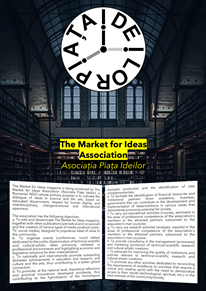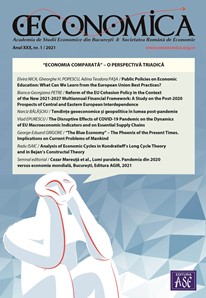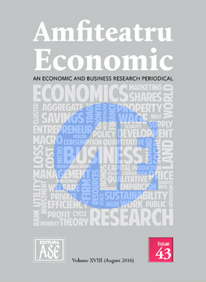
Romanian Capitalist Economic Thought (II) Brief notes on pre-1989 diasporic and post-1989 domestic debates
The first part of the article can be found here.
Domestic deadlocks
“The disappearance of Communism in Eastern Europe in 1989 reflected the collapse of the existing belief system and accordingly the weakening of its support organizations” (North 1997, 18). Such a verdict catches the image of a bivalent process of deconstruction and institutional reconstruction: from former imposition of material and moral servitudes to economic and political liberalization. But that new order – of the market and of the multiparty system – could have been accomplished, ultimately and inevitably, with the same people who inhabited the old institutional and organizational architectures, both at the top and at the base of society. The intellectual scaffolding of transformation became a critical resource, and its training and performance were, among others, functions of epistemic tradition and transfer.
Communist authoritarianism in Romania – as in Bulgaria, the GDR and Albania, but unlike Czechoslovakia, Hungary and Poland – was to be translated after 1989 into the tangled absorption of (neo)liberal ideas in statist prescription-driven reform strategies, which were connected with the nostalgia of anti-Soviet domestic national-socialism (Tismăneanu 2003). Moreover, Romania had been witnessing a lastingly and lingering skepticism towards classical liberalism, which is visible in the works of the great antebellum and interbellum economists, adherents of the neoprotectionist interventionism[1]. Then, under communist rule, the “market socialism” – an “emergency”, though hardly workable, compromise between Marxism and Neoclassicism, a stream naively theorized and tried practically in countries such as Yugoslavia and Hungary – did not lure Romanian economic researchers or policy makers[2] either. That contretemps paid tribute to mostly meteoric propinquity (yet not completely absent) of Romanian intellectual life towards the professional networks of the West[3].
The intellectual dynamics of system transformation represented the conjugation of two phenomena that can be called by two popular terms in the economic science: “path dependence” and “creative destruction”. The recovery of the ideological heritage of the Romanian economic school in the first half of the XX century, so longed for after 1989, did not contain the germs of a decisive pro-liberalization commitment. It had grown under the sign of French neomercantilism and German historiography, not embracing neoclassic marginalism, which became the language of Western economic thinking and neoliberalism. On the front of originality, the inconvenience of the regime change and the lack of previous attempts did not favour the germination of a Romanian “political economy” of transition[4].
Decisive in the Romanian transitional environment was nevertheless to be the doctrinal specialization between the “political economy of capitalism” and the “political economy of socialism”. Economists in the first category were found to be better equipped to change the track and accept the new route, to apprehend and administer the market economy, whose mechanisms had been documented before 1989 on the principle of “knowing the enemy inwardly”; liberated from dogmatic filters, they were able to present and prescribe the new reality from angles perceived either as “radical” liberal (neoclassical-monetarist, neoinstitutionalist or ordoliberal) or more “moderate” (neoclassical-Keynesian). Those in the second category grouped themselves in the left-hand side of democracy, somewhere between rhetorical neo-Marxism and instrumental Keynesianism, and dominated the beginnings of transition[5].
The state of knowledge of the dominant paradigm (“neoclassical synthesis”) was unconsolidated in the Romanian economists’ community at the beginning of transition[6]. However, neoclassicism itself was to be found globally as insufficiently sensitive to the demands of transformation, which implied not only quantitative policies (applying “instruments” to “targets”, “system parameters” being given), but also qualitative / structural policies (seeking to change the “structure” of the system, hence its “equation”). The latter required a theory of institutions and institutional change (Aligică and Evans 2009)[7], absent in the standard economic and political sciences, which rigidly-parametrically treated the “state” and the “market” as neutral setups, ignoring socio-cultural particularities, the distribution of interests and power, and social coordination and conflicts, strategy development and management, etc. The new institutionalism[8] was conceived as a both retrospective and prospective revelation about the destinies of the revolutions in the former socialist camp.
The brand of neoliberalism, meta-ideology under whose umbrella the transformation of Central Eastern Europe was placed was not so enthusiastically undertaken in Romania (despite the fears of those times), the transition starting under the sign of a “neodevelopmentalist” philosophy (Ban 2016)[9], where, for example, the state was called upon to reform the property, while remaining an important owner of critical resources. A feature of early Romanian neoliberalism was that it was rather eclectic, lacking a “hard core” laissez faire vein, which could have mentally prepared in the Romanian society a principled debate on the institutions of the free market and the statist government[10]. Instead, the energies focused on disputes that were considered more pragmatic about the optimal transition strategy: synthesized in the established and overstated expression “shock therapy vs. gradualism”. This move of accent derailed and somehow deferred the mental regeneration of the general public.
The core of the pro-market / neoliberal ideas at the beginning of the Romanian transition lies at the intersection between a reformed and pluralistic academic environment and the public institution invested with the highest degree of political independence (the National Bank of Romania – NBR). The central bank reports or the publications of newly created professional associations and research centers (SOREC[11], CEROPE[12]), by means of translations or original studies, have been the first vectors to disseminate the pro-liberalization literature. The other pole of the spectrum, read as more conservative and gradual, was the group of economists who perceived the reform as serving the repair of the old system (a kind of perestroika à la roumaine), or demanded a more cautious timing of the measures. Having a professional structure that claims interwar origins (AGER[13]), they also had a more generous political access, favoured by the visible lines of continuity between the pre-1989 and post-1989 regimes in Bucharest.
But the doctrinal demarcations cannot have been clear-cut in the early years of the transition because the great schools and the currents of thought had not fully been implanted and had no generations of internal production. What grouped economists was a mixture of personal experiences and expectations that filtered out the reading and lessons learned from them. The society, exposed to contradictory narratives, internalized the ambiguities of fault lines in the community of specialists and opinion makers. In the absence of a civic culture of the liberalism-statism distinction, the problems moved towards the speed of execution of transition: neoliberal allegations alerted the public about the social cost of delays, while their opponents played the card not of the obsolete, autarchic-protectionist interventionism, but of the modern, selective and sequential one (be it of social, commercial-investment or cultural rationales). The result would be a skeptical mindset towards capitalism, still in place in the Romanian society.
Selective references
Aligică, Paul Dragoș and Evans, Anthony J. 2009. The neoliberal revolution in Eastern Europe: economic ideas in the transition from communism. Cheltenham, UK & Northampton, MA, USA: Edward Elgar.
Åslund, Anders and Djankov, Simeon (eds.). 2014. The great rebirth: lessons from the victory of capitalism over communism. Washington, DC: Peterson Institute of International Economics.
Ban, Cornel. 2016. Ruling ideas. How global neoliberalism goes local. New York, NY: Oxford University Press.
Havrylyshyn, Oleh. 2006. Divergent paths in post-communist transformation: capitalism for all or capitalism for the few? Houndmills, UK: Palgrave MacMillan.
Institutul Național de Cercetări Economice „Costin C. Kirițescu”. 1991. Tezaur 1991, vol. VI – Colectivul interdisciplinar „Tezele I.N.C.E. privind Strategia dezvoltării economiei naționale a României”, Buletinul nr. 1(a). București, RO: Academia Română, Centrul de Informare și Documentare Economică.
Kornai, János. 1998. From socialism to capitalism: what is meant by the “change of system”. London, UK: Social Market Foundation.
Kornai, János. 2005. The great transformation of Central Eastern Europe: success and disappointment (Presidential Address, delivered at the 14th World Congress of the International Economic Association in Marrakech, Morocco on August 29, 2005), http://www.kornai-janos.hu/Kornai2006%20The%20great%20transformation%20--%20EconTrans.pdf – Accessed on 01.08.2017.
North, Douglass C. (Ed.). 1997. Transforming post-communist political economies. Washington, DC: National Resource Council, National Academy of Sciences.
Postolache, Tudorel (coord.). 1990. Schiță privind strategia înfăptuirii economiei de piață în România. București, RO: Academia Română, Institutul de Cercetare a Calității Vieții.
Tismăneanu, Vladimir. 2003. Stalinism for all seasons: a political history of Romanian communism. Berkeley & Los Angeles, CA: University of California Press.
[1] The most well-known Romanian economists are, in one way or another, followers of “economic nationalism”. The classical liberal tradition was absent not only for Romanian economists but, in general, for pre-communist Romanian intellectuals, with few exceptions in the XIX (Ion Ghica, Ioan Strat, Nicolae Şuţu) and XX centuries (Emanuel Neuman, Nicolae Steinhardt).
[2] The intra-system (not anti-system) economic critique in socialist Romania was extremely rare and out of phase. For example, János Kornai’s criticism with international audiences at the end of the 1950s had a Romanian replica only in the 1980s (Vasile Pilat and Daniel Dăianu, 1984, Revue Roumaine d’Etudes Internationales 18 (3)).
[3] A breakthrough, however, had to happen out of the necessity of the communist regime. While preserving the moratorium on the “qualitative” themes of the economic science, authorities needed in the planning system, thirsty for efficiency, economists with high “quantitative” skills, in the field of the techniques that are dense in mathematical formalism. The expanding relations with the Occident, on the background of the opposition to Moscow’s regnum, opened doors to Western universities and intergovernmental organizations for several Romanian economists. For example, input-output economic modelling, documented by a few Romanian economists – Emilian Dobrescu, Aurel Iancu, Gheorghe Zaman –, was to become a precious ally in planning processes, in a (socialist) system in which the (monetary) prices mirrored demand and supply in the economy in a distorted manner.
[4] No Romanian economist appears in the monumental treaty of Joseph A. Schumpeter (History of economic analysis, Allen & Unwin, 1954). No Romanian economist is quoted in the very comprehensive volume coordinated by Hans-Jürgen Wagener (Economic thought in communist and post-communist Europe, Routledge, 2008). The prestigious collective volume edited by Anders Åslund and Simeon Djankov (2014), following an international symposium of the Peterson Institute for International Economics, which reunited “after 25 years” key personalities of the post-socialist transition, had no Romanian author guest.
[5] See Silviu Cerna, 2012, Romanian Economic Thought in the Post-Communist Period, Œconomica 21 (2).
[6] Towards the end of the first decade of the transition, structured scientific contributions appear in the field, signed by Romanian authors. Among these, Ruhl and Dăianu (1999), Iancu (2000), Dobrescu (2002) stand out.
[7] For the link between the challenges of economic transition and the economic school of the new institutionalism, see also the volume edited by North (1997).
[8] The works of Williamson (1985) and North (1990) are road openers for the new institutionalism.
[9] “Neo-developmentalism” resembles classical developmentalism in the sense that it is based on the assumption that the world economy is made up of nation-states that compete among themselves through their companies, but deviate from its protectionist side by assuming relationships / extensive engagements with the rest of the world by stimulating direct foreign investment at the level of government, export-based strategies, and increasing the share of internally produced goods and services with medium and high added value. This path was chosen by several countries, such as Slovenia, Slovakia, Romania, Ukraine, Belarus, of course, with different degrees of developmentalism and neoliberalism (Ban 2016, 125-6), trying to overcome the challenges of post-socialism.
[10] A classical liberal reading of system transformation would have introduced in the public debate more clear issues such as: (i) the fact that the solution to the informational problem that makes socialism impossible claims complete private ownership over the factors of production (which furthermore contributes to the liberalization of prices); (ii) “the third way” is an incoherent and unstable way; (iii) the money supply must be kept away from political interference; (iv) the extent of government involvement in the economy must be minimized; (v) transition is not an anti-communist process (a fight with people), but a pro-market process (of wise institutional construction). Long before the emergence of neo-institutionalism, the Austrian School was to recover the classical liberal tradition and to inspire, to varying degrees, thinkers and currents of thoughts. In key decision points some Central and Eastern European countries have benefited from economists who had solid liberal reading, even if they “edited” them for reasons of political acceptability – Václav Klaus (Czech Republic), Leszek Balcerowicz (Poland) or Mart Laar (Estonia).
[11] Romanian Economic Society (founded in 1991); it set up the academic journal Œconomica.
[12] Romanian Center for Economic Policies (founded in 1998).
[13] The General Association of Economists in Romania (founded in 1913 and reactivated in 1990); it set up the large audience publication Economistul.








